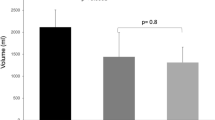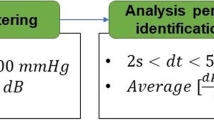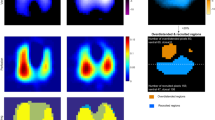Abstract
Objective
We describe a simplified helium dilution technique to measure end-expiratory lung volume (EELV) in mechanically ventilated patients. We assessed both its accuracy in comparison with quantitative computerized tomography (CT) and its precision.
Design and setting
Prospective human study.
Patients
Twenty-one mechanically ventilated ALI/ARDS patients.
Interventions
All patients underwent a spiral CT scan of the thorax during an end-expiratory occlusion. From the CT scan we computed the gas volume of the lungs (EELVCT). Within a few minutes, a rebreathing bag, containing a known amount of helium, was connected to the endotracheal tube, and the gas mixture diluted in the patient’s lungs by delivering at least ten large tidal volumes. From the final helium concentration, EELV could be calculated by a standard formula (EELVHe).
Measurement and results
The results obtained by the two techniques showed a good correlation (EELVHe=208+0.858×EELVCT, r=0.941; P<0.001). Bias between the two techniques was 32.5±202.8 ml (95% limits of agreement were −373 ml and +438 ml), with a mean absolute difference of 15%. The amount of pathological tissue did not affect the difference between the two techniques, while the amount of hyperinflated tissue did. Bias between two repeated helium EELV measurements was −24±83 ml (95% limits of agreement were –191 ml and +141 ml), with a mean absolute difference of 6.3%.
Conclusions
The proposed helium dilution technique is simple and reproducible. The negligible bias and the acceptable level of agreement support its use as a practical alternative to CT for measuring EELV in mechanically ventilated ARDS patients.




Similar content being viewed by others
Explore related subjects
Discover the latest articles and news from researchers in related subjects, suggested using machine learning.References
Ware LB, Matthay MA (2000) The Acute Respiratory Distress Syndrome. N Engl J Med 342:1334–1349
Suter PM (2002) Does the advent of (new) low tidal volume bring the (old) sigh back to intensive care unit? Anesthesiology 96:795–802
Mull RT (1984) Mass estimates by computed tomography: physical density from CT numbers. Am J Radiol 143:1101–1104
Denison DM, Morgan MD, Millar AB (1986) Estimation of regional gas and tissue volumes of the lung in supine man using computed tomography. Thorax 41:620–628
Wandtke JC, Hyde RW, Fahey PJ, Utell MJ, Plewes DB, Goske MJ, Fischer HW (1986) Measurement of lung gas volume and regional density by computed tomography in dogs. Invest Radiol 21:108–117
Malbouisson LM, Préteux F, Puybasset L, Grenier P, Coriat P, Rouby JJ (2001) Validation of a software designed for computed tomography (CT) measurement of lung water. Intensive Care Med 27:602–608
Pelosi P, Goldner M, McKibben A, Adams A, Eccher G, Caironi P, Losappio S, Gattinoni L, Marini JJ (2001) Recruitment and derecruitment during acute respiratory failure: an experimental study. Am J Respir Crit Care Med 164:122–130
Malbouisson LM, Muller JC, Constantin JM, Lu Q, Puybasset L, Rouby JJ, and CT Scan ARDS Study Group (2001) Computed tomography assessment of positive end-expiratory pressure-induced alveolar recruitment in patients with acute respiratory distress syndrome. Am J Respir Crit Care Med 163:1444–1450
Tothen HU, Sporre B, Engberg G, Wegenius G, Hedenstierna G (1993) Re-expantion of atelectasis during general anaesthesia: a computed tomography study. Br J Anaesth 71:788–795
Gattinoni L, Pesenti A, Bombino M, Baglioni S, Rivolta M, Rossi F, Rossi G, Fumagalli R, Marcolin R, Mascheroni D, Torresin A (1988) Relationships between lung computed tomographic density, gas exchange, and PEEP in acute respiratory failure. Anesthesiology 69:824–832
Kendrick AH (1996) Comparison of methods of measuring static lung volumes. Monaldi Arch Chest Dis 51:431–439
Heldt GP, Peters RM (1978) A simplified method to determine functional residual capacity during mechanical ventilation. Chest 74:492–496
Weaver LJ, Pierson DJ, Kellie R, Bonner B, Craig KC (1981) A practical procedure for measuring functional residual capacity during mechanical ventilation with or without PEEP. Crit Care Med 9:873–877
Ibanez J, Raurich JM, Moris SG (1983) Measurement of Functional Residual Capacity during mechanical ventilation. Comparison of a computerized open nitrogen washout method with a closed helium dilution method. Intensive Care Med 9:91–93
Macnaughton PD, Morgan CJ, Denison DM, Evans TW (1993) Measurement of carbon monoxide transfer and lung volume in ventilated subjects. Eur Respir J 6:231–236
Macnaughton PD, Evans TW (1994) Measurement of lung volume and DLCO in acute respiratory failure. Am J Respir Crit Care Med 150:770–775
Fretshner R, Deusch H, Weitnauer A, Brunner JX (1993) A simple method to estimate functional residual capacity in mechanically ventilated patients. Intensive Care Med 19:372–376
Wrigge H, Sydow M, Zinserling J, Neumann P, Hinz J, Burchardi H (1998) Determination of functional residual capacity (FRC) by multibreath nitrogen washout in a lung model and in mechanically ventilated patients. Intensive Care Med 24:487–493
Jonmarker C, Jansson L, Jonson B, Larsson A, Werner O (1985) Measurement of functional residual capacity by sulfur hexafluoride washout. Anesthesiology 63:89–95
East TD, Wortelboer PJM, Van Ark E, Bloem FH, Peng L, Pace NL, Crapo RO, Drews D, Clemmer TP (1990) Automated sulfur hexafluoride washout functional residual capacity measurement system for any mode of mechanical ventilation as well as spontaneous respiration. Crit Care Med 18:84–91
Hedestierna G (1993) The recording of FRC— is it of importance and can it be made simple? Intensive Care Med 19:365–366
Gattinoni L, Pesenti A, Avalli L, Rossi F, Bombino M (1987) Pressure-volume curve of total respiratory system in acute respiratory failure: computed tomographic scan study. Am Rev Resp Dis 136:730–736
Gattinoni L, Pelosi P, Suter PM, et al (1998) Acute Respiratory Distress Syndrome caused by pumonary and extrapulmonary disease, different syndromes? Am J Respir Crit Care Med 158:3–11
Foti G, Cereda M, Sparacino ME, De Marchi L, Villa F, Pesenti A (2000) Effects of periodic lung recruitment maneuvers on gas exchange and respiratory mechanics in mechanically ventilated acute respiratory distress syndrome (ARDS) patients. Intensive Care Med 26:501–507
Bernard GR, Artigas A, Brigham KL, Carlet J, Falke K, Hudson L, Lamy M, Legall JR, Morris A, Spragg R (1994) The American-European Consensus Conference on ARDS. Definitions, mechanisms, relevant outcomes and clinical trial coordination. Am J Respir Crit Care Med 149:818–824
Gottfried SB, Higgs BD, Rossi A, Carli F, Mengeot PM, Calverly PM, Zocchi L, Milic-Emili J (1985) Interrupter technique for measurement of respiratory mechanics in anesthetized humans. J Appl Physiol 59:647–652
(2000) Appendix C. In: Lumb (ed) Nunn’s applied respiratory physiology. Butterworth Heinemann, Oxford Auckland Boston Johannesburg Melbourne New Delhi, pp 647–649
Gattinoni L, Pesenti A, Torresin A, Baglioni S, Rivolta M, Rossi F, Scarani F, Marcolin R, Cappelletti G (1986) Adult respiratory distress syndrome profiles by computed tomography. J Thorac Imaging 1:25–30
Bland JM, Altman DG (1986) Statistical methods for assessing agreement between two methods of clinical measurement Lancet 8:307–310
Clausen J (1997) Measurement of absolute lung volumes by imaging techniques (1997) Eur Respir J 10:2427–2431
Brenner DE, Whitley NO, Houk TL, Aisner J, Wiernik P, Whitley J (1982) Volume determination in computed tomography. JAMA 247:1299–1302
Brown MS, McNitt-Gray MF, Goldin JG, Greaser LE, Hayward UM, Sayre JW, Arid MK, Aberle DR (1999) Automated measurement of single and total lung volume from CT. J Comput Assist Tomogr 23:632–640
Kauczor HU, Heussel CP, Fischer B, Klamm R, Mildenberger P, Thelen M (1998) Assessment of lung volumes using helical CT at inspiration and expiration: comparison with pulmonary function tests. Am J Roentgenol 171:1091–1095
Kinsella M, Muller NL, Abboud RT, Morrison NJ, DyBuncio A (1990) Quantitation of emphysema by computed tomography using a “density mask” program and correlation with pulmonary function tests Chest 97:315–321
Darling RC, Cournand A, Richards DW Jr (1944) Studies on intrapulmonary mixture of gases: 5. Forms of inadequate ventilation in normal and emphysematous lungs, analyzed by means of breathing pure oxygen. J Clin Invest 23:55–67
Weygandt GR (1976) A sensitive five-breath N2 washout test of distribution of ventilation. J Appl Physiol 40:464–467
Russell NJ, Bagg LR, Dobrzynski J, Hughes DT (1983) Clinical assessment of a rebreathing method for measuring pulmonary gas transfer. Thorax 38:212–215
Dantzker DR, Brook CJ, Dehart P, Lynch JP, Weg JG (1979) Ventilation-perfusion distribution in adult respiratory distress syndrome. Am Rev Respir Dis 120:1039–1052
Koutsoukou A, Armaganidis A, Stavrakaki-Kallergi C, Vassilakopoulos T, Lymberis A, Roussos C, Milic-Emili J (2000) Expiratory flow limitation and intrinsic positive end-expiratory pressure et zero positive end expiratory pressure in patients with adult respiratory distress syndrome. Am J Respir Crit Care Med 161:1590–1596
Drummond GB (1998) Computed tomography and pulmonary measurements. Br J Anaesth 80:665–671
Eichler W, Schumacher J, Roth-Isigkeit A, Braun J, Kuppe H, Klotz KF (2002) Automated evaluation of functional residual capacity by oxygen washout. J Clin Monit 17:195–201
Author information
Authors and Affiliations
Corresponding author
Additional information
Supported by: MIUR
Rights and permissions
About this article
Cite this article
Patroniti, N., Bellani, G., Manfio, A. et al. Lung volume in mechanically ventilated patients: measurement by simplified helium dilution compared to quantitative CT scan. Intensive Care Med 30, 282–289 (2004). https://doi.org/10.1007/s00134-003-2109-0
Received:
Accepted:
Published:
Issue Date:
DOI: https://doi.org/10.1007/s00134-003-2109-0
Keywords
Profiles
- Nicolò Patroniti View author profile
- Antonio Pesenti View author profile




